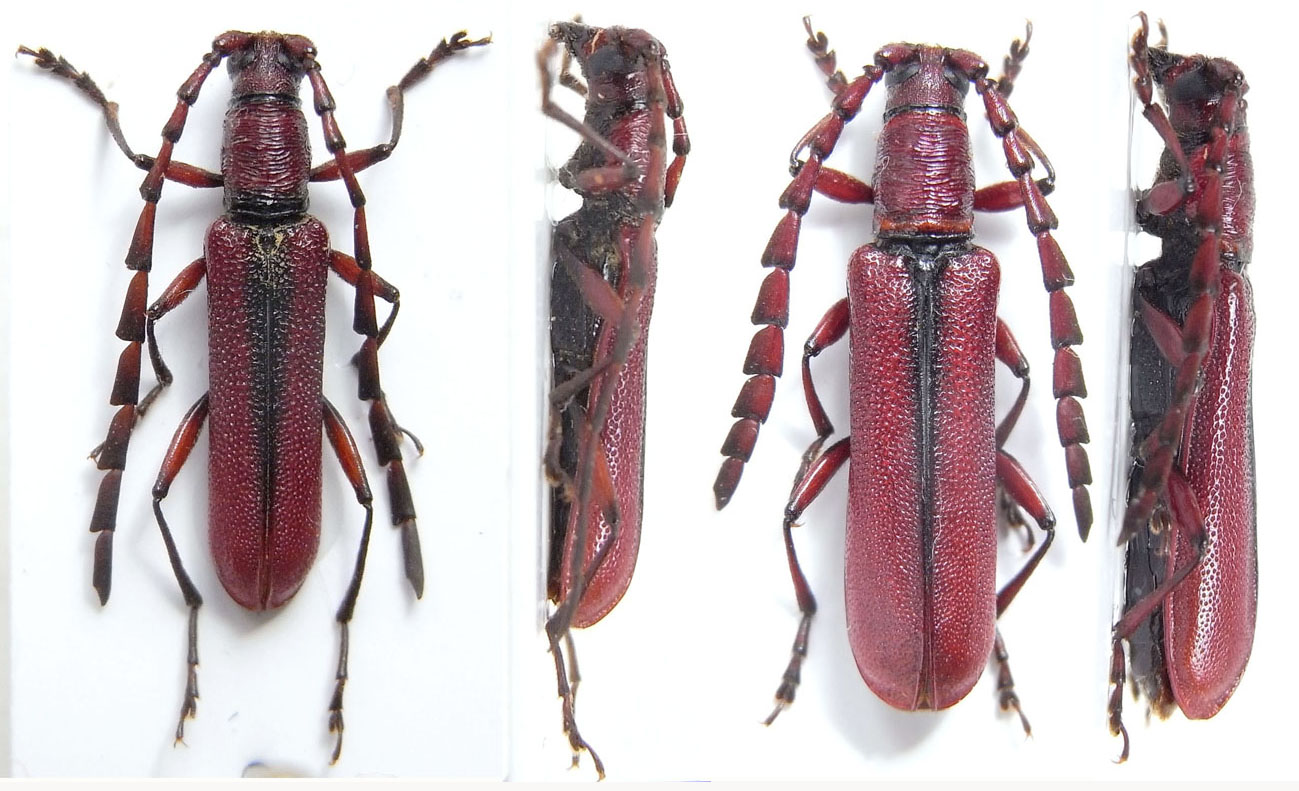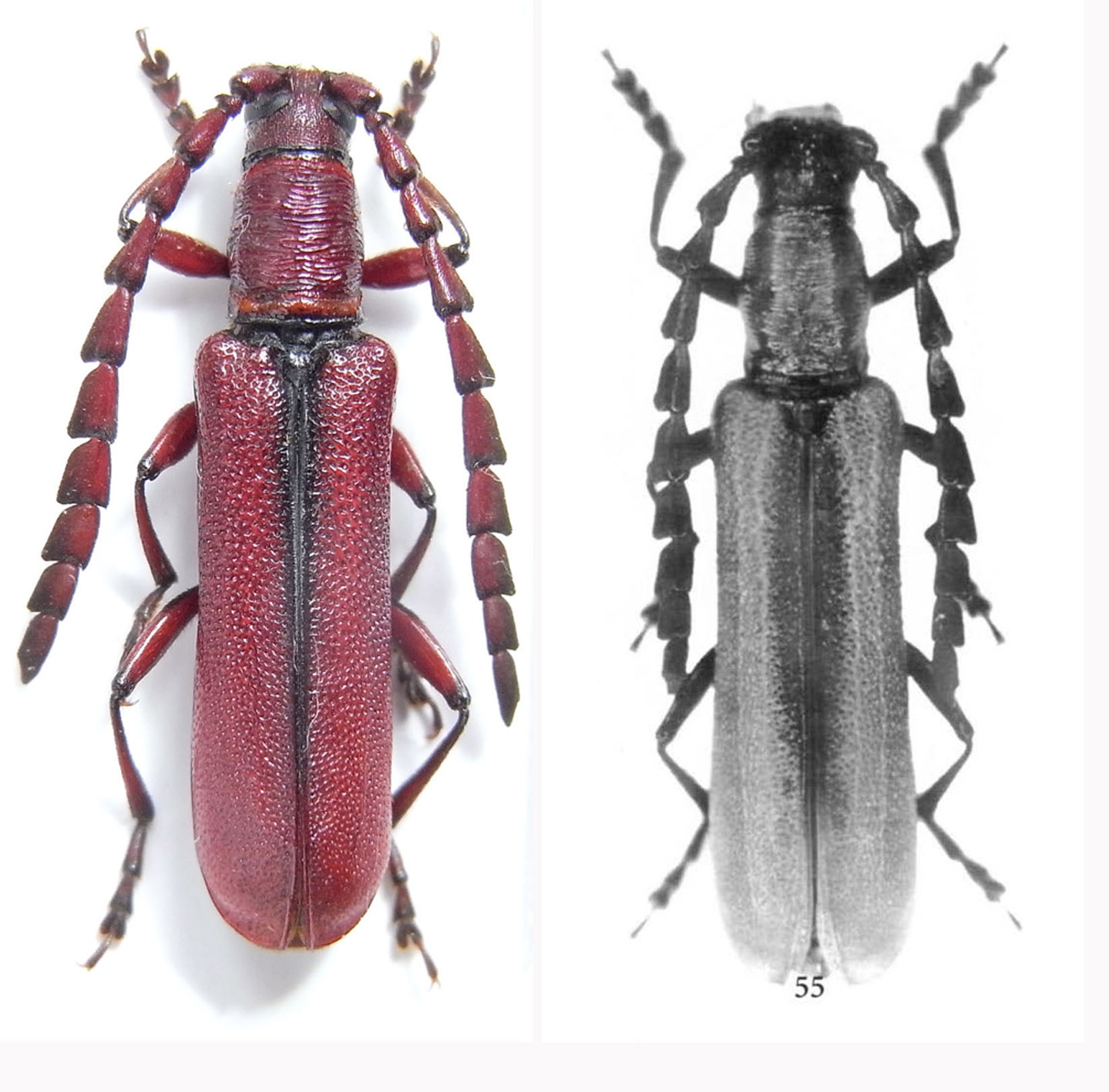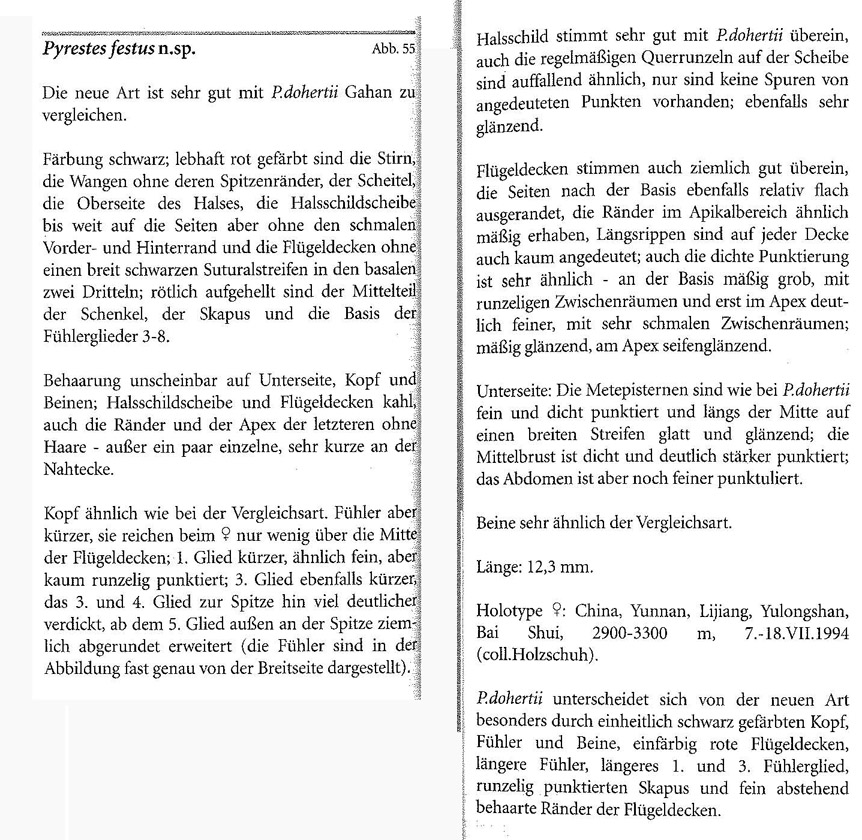| Author |
 Topic Topic  |
|
|
Xavier
Scientific Collaborator
    
France
12203 Posts |
 Posted - 28/12/2012 : 08:02:15 Posted - 28/12/2012 : 08:02:15



|

Hua Phan, nord Laos. 9 à 13 mm . Au vol, sur les chemins en lisière de forêt, en mai.
Tête : Rouge. Finement ponctuée, pileuse à l’insertion des antennes. Joues rouges en bordure des yeux, puis noires ; mandibules noires
Antennes : Segments rouges à l’apex noir. Segments 1 à 4 bordés de rares poils rouge brun courts et recourbés. Segment 1 légèrement plus court que le 3 ; segment 5 en triangle à l’angle extérieur tronqué, ½ fois plus long que large à la base (femelle), 2 fois plus long que large (mâle).
Femelle : 5 = 2+3, 5>6, 6 à 10 diminuant progressivement, 11=5. Antenne atteignant les 2/3 des élytres
Mâle : 1=4, 5=2+3=6, 5>4, 6 à 10 égaux, 11 plus long que les 5 précédents. Antenne atteignant l’apex des élytres.
Pronotum Glabre, finement ridé transversalement, sans ponctuation, rouge sur le disque, bordé de rouge plus clair avant l’apex qui est bordé de noir comme la base. Plus large à l’apex, subconique aux côtés faiblement arrondis, et étranglés avant l’apex.
Scutellum noir, base étroite, deux fois plus large au milieu qu’à la base, apex en triangle
Suture noire, déprimée à la base, s’élevant sur le disque, plus rouge et élevée à l’apex. Plus noire sur le disque chez le mâle.
Elytres Rouges, noires sur le disque le long de la suture, glabres, régulièrement ponctués (points contigus), plus fortement sur le disque, plus finement à l’apex et sur les côtés. Aussi larges à la base qu’à l’apex, régulièrement moins larges vers le milieu et presque parallèles. Epaules finement ponctuées.
Pattes Fémurs rouges, articulations noires, tibias sombres bordés de poils courts. Tarses rougeâtres aux apex noirs.
Tarses postérieurs : femelle 1=2+3, mâle 1>2+3 |
Edited by - Xavier on 24/06/2014 13:22:06 |
|
|
Xavier
Scientific Collaborator
    
France
12203 Posts |
 Posted - 06/01/2013 : 19:32:43 Posted - 06/01/2013 : 19:32:43



|
| Avec Gressitt (1970), mon ami znort et moi-même arrivons à Pyrestes dohertii Gahan, 1906 |
 |
|
|
horshehden
Member Purpuricenus
 
Czech Republic
424 Posts |
 Posted - 06/01/2013 : 20:03:16 Posted - 06/01/2013 : 20:03:16



|
Sorry, but you should start again. P. dohertii should have black antennae (see Gahan, 1906).
You did not provided photo of P. dohertii in your collection from NE Laos, although I should have some specimens from that place. |
 |
|
|
Xavier
Scientific Collaborator
    
France
12203 Posts |
 Posted - 06/01/2013 : 20:14:20 Posted - 06/01/2013 : 20:14:20



|
Oh, thank you...could you help us on one or two species  ? ? |
 |
|
|
znort
Member Purpuricenus
 
China
486 Posts |
 Posted - 06/01/2013 : 20:23:49 Posted - 06/01/2013 : 20:23:49



|
| Could you post your dohertii photo's???? |
Chinese Cerambycidae |
 |
|
|
horshehden
Member Purpuricenus
 
Czech Republic
424 Posts |
 Posted - 06/01/2013 : 21:20:37 Posted - 06/01/2013 : 21:20:37



|
Unfortunately, I had no time yet to study these two genera carefuly (Pyrestes & Erythrus). When I finish it, I will let you know my opinion for sure.
There's P. dohertii photo in this forum - it should be correct. |
 |
|
|
Xavier
Scientific Collaborator
    
France
12203 Posts |
 Posted - 24/06/2014 : 13:19:25 Posted - 24/06/2014 : 13:19:25



|
Identification with Sergi's help : Pyrestes festus Holzschuh, 1998
The black sutural stripe fits the original type picture in the publication. |
 |
|
|
Xavier
Scientific Collaborator
    
France
12203 Posts |
 Posted - 25/06/2014 : 14:00:25 Posted - 25/06/2014 : 14:00:25



|
Tom desagree with this ID; I add here original type's picture to compare, and the text.

Pyrestes sp. north-east Laos vs Pyrestes festus, Holzschuh 1998
Are antenna black or bicolor ?

Help wanting for translation in english  |
Edited by - Xavier on 25/06/2014 14:10:15 |
 |
|
| |
 Topic Topic  |
|
|
|


